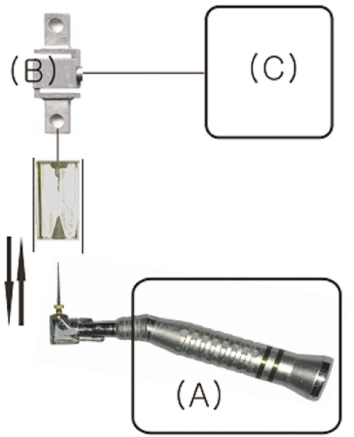J Korean Acad Conserv Dent.
2010 Jul;35(4):267-272. 10.5395/JKACD.2010.35.4.267.
Comparison of screw-in effect for several nickel-titanium rotary instruments in simulated resin root canal
- Affiliations
-
- 1Department of Conservative Dentistry, School of Dentistry, Kyungpook National University, Daegu, Korea. skykim@knu.ac.kr
- KMID: 2176384
- DOI: http://doi.org/10.5395/JKACD.2010.35.4.267
Abstract
- Screw-in effect is one of the unintended phenomena that occurs during the root canal preparation with nickel-titanium rotary files. The aim of this study was to compare the screw-in effect among various nickel-titanium rotary file systems. Six different nickel-titanium rotary instruments (ISO 20/.06 taper) were used: K3(TM) (SybronEndo, Glendora, CA, USA), Mtwo (VDW GmbH, Munchen, Germany), NRT with safe-tip and with active tip (Mani Inc., Shioya-gun, Japan), ProFile(R) (Dentsply-Maillefer, Ballaigues, Switzerland) and ProTaper(R) (Dentsply-Maillefer, Ballaigues, Switzerland). For ProTaper(R), S2 was selected because it has size 20. Root canal instrumentations were done in sixty simulated single-curved resin root canals with a rotational speed of 300 rpm and single pecking motion. A special device was designed to measure the force of screw-in effect. A dynamometer of the device recorded the screw-in force during simulated canal preparation and the recorded data was stored in a computer with designed software (LCV-USE-VS, Lorenz Messtechnik GmbH, Alfdorf, Germany). The data were subjected to one-way ANOVA and Tukey's multiple range test for post-hoc test. P value of less than 0.05 was regarded significant. ProTaper(R) produced significantly more screw-in effects than any other instruments in the study (p < 0.001). K3(TM) produced significantly more screw-in effects than Mtwo, and ProFile(R) (p < 0.001). There was no significant difference among Mtwo, NRT, and ProFile(R) (p > 0.05), and between NRT with active tip and NRT with safe one neither (p > 0.05). From the result of the present study, it was concluded, therefore, that there seems significant differences of screw-in effect among the tested nickel-titanium rotary instruments. The radial lands and rake angle of nickel-titanium rotary instrument might be the cause of the difference.
MeSH Terms
Figure
Cited by 3 articles
-
Influence of taper on the screw-in effect of nickel-titanium rotary files in simulated resin root canal
Hye-Jin Sung, Jung-Hong Ha, Sung-Kyo Kim
J Korean Acad Conserv Dent. 2010;35(5):380-386. doi: 10.5395/JKACD.2010.35.5.380.Influence of root canal curvature on the screw-in effect of nickel-titanium rotary files in simulated resin root canal
Ji-Young Son, Jung-Hong Ha, Young-Kyung Kim
J Korean Acad Conserv Dent. 2010;35(5):374-379. doi: 10.5395/JKACD.2010.35.5.374.Influence of glide path on the screw-in effect and torque of nickel-titanium rotary files in simulated resin root canals
Jung-Hong Ha, Sang-Shin Park
Restor Dent Endod. 2012;37(4):215-219. doi: 10.5395/rde.2012.37.4.215.
Reference
-
1. Schilder H. Cleaning and shaping the root canal. Dent Clin North Am. 1974. 18:269–296.2. Walia H, Brantley WA, Gerstein H. An initial investigation of the bending and torsional properties of Nitinol root canal files. J Endod. 1988. 14:346–351.
Article3. Glossen CR, Haller RH, Dove SB, del Rio CE. A comparison of root canal preparations using nickel-titanium hand, nickel-titanium engine-driven, and K-flex endodontic instruments. J Endod. 1995. 21:146–151.4. Huh YJ, Kim SK. Change in root canal configuration using different file types and techniques. J Korean Acad Conserv Dent. 1997. 22:291–304.5. Park WK, Lee HJ, Hur B. Shaping ability of nickel-titanium rotary files. J Korean Acad Conserv Dent. 2004. 29(1):44–50.6. Yun HH, Kim SK. A comparison of the shaping abilities of 4 nickel-titanium rotary instruments in simulated root canals. Oral Surg Oral Med Oral Pathol Oral Radiol Endod. 2003. 95:228–233.
Article7. Short JA, Morgan LA, Baumgartner JC. A comparison of canal centering ability of four instrumentation technique. J Endod. 1997. 23:503–507.
Article8. Swartz DB, Skidmore AE, Griffin JA Jr. Twenty years of endodontic success and failure. J Endod. 1983. 9(5):198–202.
Article9. Sjögren U, Hägglund B, Sundqvist G, Wing K. Factors affecting the long-term result of endodontic treatment. J Endod. 1990. 16(10):498–504.10. Smith CS, Setchell DJ, Harty FJ. Factors influencing the success of conventional root canal therapy-a five-year retrospective study. Int Endod J. 1993. 26:321–333.
Article11. Malueg LA, Wilcox LR, Johnson W. Examination of external apical root resorption with scanning electron microscopy. Oral Surg Oral Med Oral Pathol Oral Radiol Endod. 1996. 82:89–93.
Article12. Gutierrez JH, Brizuela C, Villota E. Human teeth with periapical pathosis after overinstrumentation and overfilling of the root canals: a scanning electron microscopic study. Int Endod J. 1999. 32:40–48.
Article13. Tronstad L, Andreasen JO, Hasselgren G, Kristerson I, Ris T. pH changes in dental tissue after root canal filling with calcium hydroxide. J Endod. 1981. 7(1):17–21.
Article14. Nehammer CF. Treatment of the emergency patient. Br Dent J. 1985. 158:245–248.
Article15. Seltzer S, Soltanoff W, Sinai I, Goldenberg A, Bender IB. Biologic aspects of endodontics. Part III. Periapical tissue reaction to root canal instrumentation. Oral Surg Oral Med Oral Pathol. 1968. 26(4):534–546.16. Di Fiore PM. A dozen way to prevent nickel-titanium rotary instrument fracture. J Am Dent Assoc. 2007. 138:196–201.17. Li UM, Lee BS, Shih CT, Lan WH, Lin CP. Cyclic fatigue of endodontic nickel titanium rotary instruments: static and dynamic test. J Endod. 2002. 28(6):448–451.
Article18. Gulabivala K, Abdo S, Sherriff M, Regan JD. The influence of interfacial forces and duration of filing on root canal shaping. Endod Dent Traumatol. 2000. 16:166–174.
Article19. Oh SH, Park JK, Hur B, Kim HC. Comparison of screw-in effect of three NiTi file systems used by undergraduates. J Korean Acad Conserv Dent. 2006. 31(6):477–484.
Article20. Diemer F, Calas P. Effect of pitch length on the behavior of rotary triple helix root canal instruments. J Endod. 2004. 30(10):716–718.
Article
- Full Text Links
- Actions
-
Cited
- CITED
-
- Close
- Share
- Similar articles
-
- Influence of root canal curvature on the screw-in effect of nickel-titanium rotary files in simulated resin root canal
- Influence of taper on the screw-in effect of nickel-titanium rotary files in simulated resin root canal
- Influence of glide path on the screw-in effect and torque of nickel-titanium rotary files in simulated resin root canals
- Shaping ability of nickel-titaniumrotary files
- Shaping ability of four rotary nickel-titanium instruments to prepare root canal at danger zone


